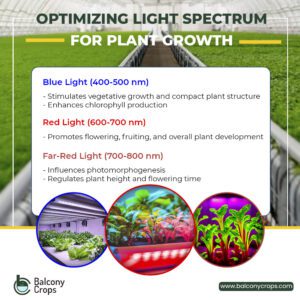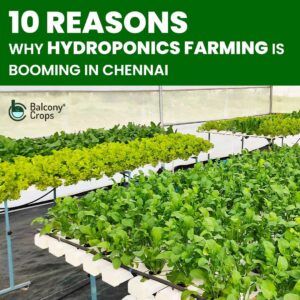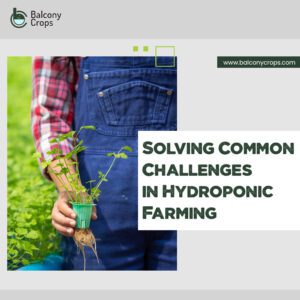Table of Contents
Introduction:
The success of leafy greens, vivid fruits, and healthy harvests all depends on proper Lighting. Get ready to illuminate the fascinating world of hydroponic farming. So, let’s embark on a journey to uncover the secrets behind optimal lighting conditions in hydroponics. Dive in and discover the enlightening power of light!
The Role of Lighting in Hydroponics:
Lighting plays a pivotal role in hydroponic farming, acting as a substitute for sunlight in indoor growing environments. It provides the energy necessary for photosynthesis, the process through which plants convert light into chemical energy to fuel their growth. Without adequate light, plants struggle to produce the essential nutrients needed for healthy development. Proper lighting not only ensures optimal growth but also influences crucial factors like plant morphology, flowering, and fruiting. Let’s explore how to harness the power of light to maximize your hydroponic farming success.
Choosing the Right Grow Lights:
Selecting the right grow lights for your hydroponic setup is crucial. Here are some key factors to consider:
- Light Source: LED (Light Emitting Diode) lights are a popular choice due to their energy efficiency, longevity, and adjustable spectrum. High-Pressure Sodium (HPS) and Metal Halide (MH) lights are also commonly used in commercial hydroponic farming.
- Energy Efficiency: Look for grow lights with high energy efficiency ratings, as they consume less electricity while providing ample light output.
- Spectrum Control: Optimal plant growth requires a balanced light spectrum. Consider lights that allow you to customize the spectral output, tailoring it to your crop’s specific needs.
Light Intensity and Duration Requirements for Plants:
Just as humans require the right amount of sunlight for various activities, plants also have specific light intensity and duration requirements for optimal growth. The intensity of light needed depends on the plant species and growth stage. Leafy greens, like lettuce, thrive under lower light intensities, while fruiting plants, such as tomatoes, demand higher intensities. Similarly, the duration of light exposure varies during different growth stages. Seedlings require longer periods of light exposure, while mature plants can thrive with slightly reduced hours. Monitoring and adjusting light intensity and duration based on plant needs are crucial for achieving healthy growth and avoiding issues like leggy plants or stunted development.
Optimizing Light Spectrum for Plant Growth :

Plants respond differently to different parts of the light spectrum. Consider the following points when optimizing the light spectrum for your crops:
- Blue Light (400-500 nm): Stimulates vegetative growth, compact plant structure, and chlorophyll production.
- Red Light (600-700 nm): Promotes flowering, fruiting, and overall plant development.
- Far-Red Light (700-800 nm): Influences photomorphogenesis, regulating plant height, and flowering time.
Supplemental Lighting for Enhanced Results:
In some cases, supplemental lighting can be beneficial for boosting plant growth and yields. Here are a few instances where supplemental lighting can make a difference:
- Winter Months: When natural sunlight is limited, supplementing with artificial lighting ensures consistent growth.
- Low-Light Areas: If your hydroponic setup is located in a shaded or windowless area, supplemental lighting can provide the necessary light energy.
- Extended Photoperiods: Certain crops, like herbs or microgreens, benefit from extended light exposure beyond daylight hours.
Managing Light Distribution in Hydroponic Systems :
Ensuring adequate light distribution is similar to directing a symphony of growth in hydroponic farming. Just like each instrument has its part to play, every plant in your system deserves its fair share of light. Here’s how you can master the art of managing light distribution in your hydroponic setup.
- Light Positioning: Treat your grow lights like the conductors of brightness. Place them strategically, making sure they’re at the right distance from your plants. This prevents the chance of burning or stretching. As your crops grow taller, adjust the height of the lights to keep them at the perfect distance.
- Reflective Surfaces: Incorporating reflective surfaces in your hydroponic system, such as Mylar or white paint on walls, can amplify the reach of your light. These surfaces bounce and reflect the precious photons, ensuring that no plant is left in the shadows.
- Rotational Systems: Imagine a conductor who rotates musicians to showcase their skills. Similarly, you can incorporate rotating shelves or trays in your hydroponic setup. This clever technique ensures that every side of your plants receives an equal amount of light. By preventing uneven growth, it ensures that each plant gets its fair share of the spotlight, leading to healthier and more balanced development.
By fine-tuning the positioning of your lights, utilizing reflective surfaces, and embracing rotational systems, you’ll orchestrate a symphony of light that nurtures your hydroponic plants. With careful management, you’ll witness a bountiful harvest where every crop performs its best, harmonizing with the power of light. So, let the magic of light distribution transform your hydroponic system into a captivating spectacle of growth and abundance.
Conclusion
In hydroponic farming, providing proper lighting conditions is essential for achieving optimal plant growth and maximizing yields. By choosing the right grow lights, understanding light intensity and duration requirements, optimizing the light spectrum, and managing light distribution, you can create an ideal environment for your hydroponic crops. Remember, lighting is a key investment that pays off in the form of healthy, vibrant plants and bountiful harvests.
Ready to take your hydroponic farming to the next level? Contact us at Balcony Crops for expert consultation and guidance on commercial hydroponic farming and also check out our hydroponic kits in Chennai.









